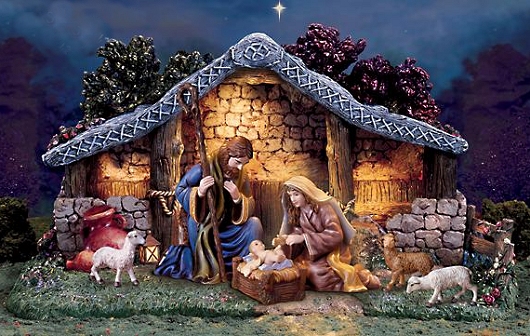From Wikipedia, the free encyclopedia
Nativity Scene
An elaborate Neapolitan presepio
Living nativity at St. Wojciech Church, Wyszków, Poland, 2006
A nativity scene, manger scene, krippe, crèche, or crib, is a depiction of the birth of Jesus as described in the gospels of Matthew and Luke. While the term "nativity scene" typically includes two dimensional depictions in film, painting, printmaking, and other media, in the history of art and culture, as well as in popular use, the term refers to static, three dimensional, artistic, commercial or folk art dioramas, or pantomimes called "living nativity scenes" in which real humans and animals participate. Nativity scenes exhibit figures representing the infant Jesus, his mother Mary, and Joseph. Other characters from the nativity story such as shepherds, the Magi, and angels may be displayed near the manger or stable.
Saint Francis of Assisi is credited with creating the first nativity scene in 1223 (a "living" one) intending thereby to cultivate the worship of Christ, having been inspired by his recent visit to the Holy Land where he had been shown Jesus's traditional birthplace. The scene's popularity inspired communities throughout Christendom to stage similar pantomimes; eventually, the nativity scene became an archetype in Western culture, inspiring an infinite number of works of high and popular art. More and more elaborate static exhibitions were created with wax and ivory figurines garbed in rich fabrics set against intricate landscapes. These elaborate scenes reached their artistic apogee in the Kingdom of Naples in the 16th to 18th centuries. Elsewhere, the emphasis was on realism.
Distinctive nativity scenes and traditions have been created around the world and are displayed during the Christmas season in churches, homes, shopping malls, and other venues, and occasionally on public lands and in public buildings. The Vatican has displayed a scene in St. Peter's Square near its Christmas tree since 1982 and the Pope has for many years blessed the mangers of children assembled in St. Peter's Square for a special ceremony. Folk art traditions in Europe include the hand-painted santons of France and the colorful szopka of Poland. In the United States, the Metropolitan Museum of Art in New York City annually displays a Neapolitan Baroque nativity scene before a twenty-foot blue spruce.
Nativity scenes have not escaped controversy. A life-sized scene in the United Kingdom featuring waxworks celebrities provoked outrage in 2004, and, in Spain, a city council forbade the exhibition of a traditional toilet humor character in a public nativity scene. People for the Ethical Treatment of Animals (PETA) indicates that animals in living displays lack proper care and suffer abuse. In the United States, nativity scenes on public lands and in public buildings have provoked court challenges, and the prankish theft of ceramic or plastic nativity figurines from outdoor displays has become commonplace.






















